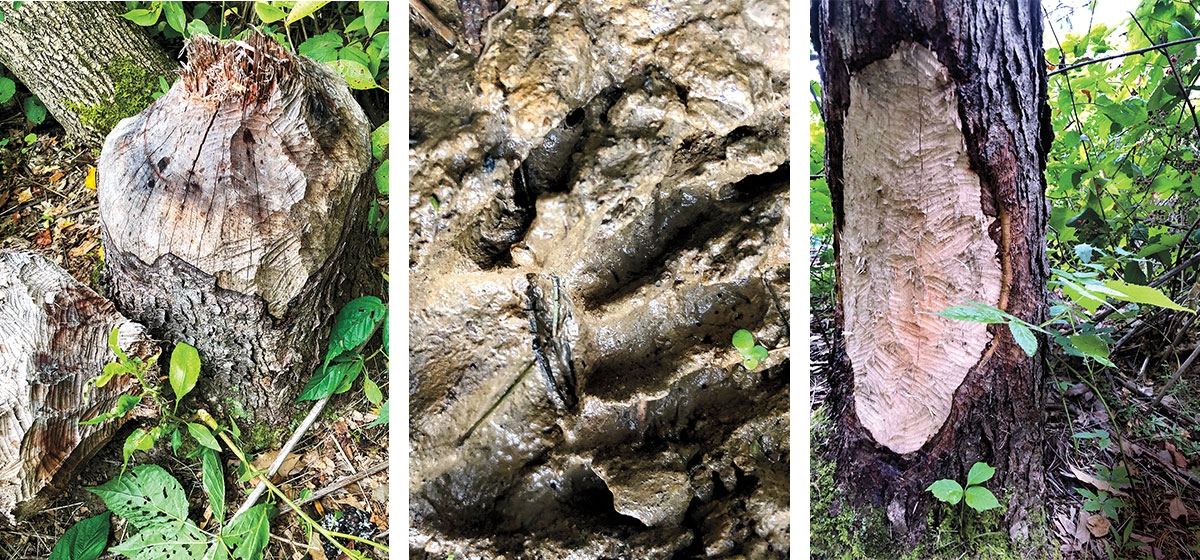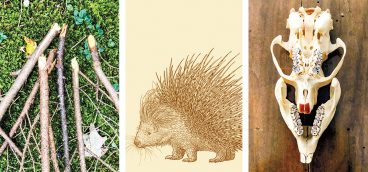Beavers Don’t Get Headaches

“A beaver sits on the riverbank watching all of this unfold.” —from “Cairo” by Sara Miller
In my small and random survey, people know, at the very least, that beavers chew wood, build dams, have big teeth and large tails. That’s about all I knew, until beavers moved into our farm pond. Turns out North America’s largest rodent, Castor canadensis, is a fascinating creature, and there’s a lot more to learn.
A few basic beaver facts: they’re three to four feet long, weigh up to 70 lbs., and have fur ranging from blonde to charcoal. Propelled by webbed hind feet, beavers can swim up to six miles per hour and stay underwater for 15 minutes. They’re herbivores, live in family-oriented colonies, are territorial, and mostly nocturnal. Semi-aquatic, beavers have eyes with a translucent third eyelid so they can see underwater, valves on their ears and noses that shut when submerged, and skin flaps behind their teeth that allow them to haul branches without swallowing water.
But here are some of my favorite beaver facts: their teeth are orange—due to the enamel’s iron content—self-sharpen, and grow continually. Incisors that aren’t aligned properly can prevent beavers from gnawing, grow too long, and cause a beaver to starve to death. In autumn, beavers drag tree branches to the bottom of a pond and stick them into mud, creating a winter larder. Native Americans called the beaver “the sacred center of the earth” because their dam-building creates a habitat for so many creatures.
The sound of running water drives them crazy. They think their dam has sprung a leak and run to patch it. “They’re like the Army Corps of Engineers,” said Dr. Thorvald Holmes, a retired biologist at Humboldt State University in California. “If they stop the sound of water, they’ll create a pond and they’re in business. If they don’t pay attention to running water, it reduces the likelihood of being a successful beaver.” Beavers have an outer fur and an under fur, which Holmes said acts as a wet suit. Air gets trapped between these layers, and if they don’t dive deep, their bodies never get wet.
“Grooming is also a big deal for a beaver,” Holmes said, “because if you undermine that under fur, if it gets greasy or sticky, it loses its insulating properties.” He said the easiest task to see a beaver do is preen (the hind feet have special preening toes) “and tease their hair to make sure they have loft in their under fur.” Beavers’ scaly tails are pretty amazing too: they slap them against the water to warn of danger, balance on them to stand upright, and use them as a rudder when swimming. Fat is stored in the tail for winter and it regulates body temperature. Trappers were known to roast the fatty appendage on an open fire.
Beaver can be eaten during lent since in the 17th century the Catholic Church declared that because beavers spend so much time in the water, they could be considered a fish. Bootleggin’ BBQ in St. Louis, Missouri first put beaver on their Lenten menu in 2016, marinating it with brown sugar and grilling it, serving it with mashed potatoes, and making it into tacos or boudin balls. Brenton Brown, partner and pitmaster, wore a t-shirt during lent printed with the words: “God said it was OK.”
In other non-scientific realms, the beaver is an official emblem of Canada, featured opposite Queen Elizabeth on the Canadian nickel, because according to the Canadian Dictionary, beavers are noted for their “industry, skill and perseverance, qualities considered suitable for a nation to emulate.”
Between 60 million and 400 million beavers lived in North America before European settlers arrived and nearly wiped them out. “The single most important species in the fur trade was the beaver,” Holmes said. (In 1903, Pennsylvania protected beavers, reintroduced them, and now they live across our state.) The beaver’s outer fur was used for coats, but the under fur, which Holmes described as “velvety, glossy and luxurious” was most coveted and pressed into felt for fancy hats, including top hats. Beavers were also trapped for castoreum, used in perfume (castoreum hold its scent a long time, Holmes said), in medicine, and as a food additive, which comes from one of the anal glands near the beaver’s tail, secretions from which the beaver uses to mark territory and rub on their fur to repel water. Holmes thinks the smell resembles “wet leather,” others claim vanilla, and in a video, “The Beaver: Its Life and Impact,” biologist and beaver expert Dr. Dietland Muller-Schwarze claimed castoreum imparts “a wild animal note.”
My husband first noticed our beaver activity when mowing the field around the pond. The weeping willows he’d so tenderly planted had been felled, as well as cherry and ash trees, the recognizable “V” shape in the wood typical of beaver activity. Beavers like willow because it’s easy to peel; willow also contains salicylic acid, the same ingredient as aspirin. “The willow cure,” Holmes joked, “they don’t get headaches.” Beavers strip tree bark by turning the branch like an ear of corn, trying to reach the cambium, a sweet, nutritious layer between the bark and wood. They can’t digest everything they chew so they eat their feces to extract all possible nutrients. They also eat aquatic plants such as cattails and water lilies, both of which we have in abundance at our pond.
Around the pond’s perimeter, we noticed multiple lodges built of sticks and mud, but what we couldn’t see below were separate rooms for giving birth, sleeping and eating, an underwater entrance, or an air vent, common in beaver lodges. Most lodges contain a single family of 2 to 12, including a breeding pair, kits and yearlings. Yearlings generally help raise the newborns and stay with their parents until around age two, then venture off on their own. Beavers often mate for life, and breeding season is January through March, gestation about three months, and average litter size is three to five kits. According to the Smithsonian zoo website, babies swim inside the lodge a half hour after birth. Beavers don’t hibernate, but mostly stay inside the lodge during winter.
Beavers are touted for being nature’s engineers, creating habitats for animals such as moose, deer, fish, waterfowl, otters, mink, songbirds and frogs, among others. “If humans are the world’s most influential mammals, beavers have a fair claim at second place,” wrote Ben Goldfarb in “Eager: The Surprising, Secret Life of Beavers and Why They Matter.” In his book, Goldfarb asks his readers to appreciate the many benefits beavers bring to the environment. “Beavers are environmental Swiss Army knives, capable of tackling just about any ecological dilemma,” he writes. “Trying to slow down floods or filter out pollution? There’s a beaver for that. Hoping to capture more water for agriculture in the face of climate change? Add a beaver. Concerned about erosion, salmon runs, or wildfire? Take two beaver families and check back in a year.”
But what’s a homeowner to do when beavers build a dam on your spillway, which could cause a pond to breach its bank? Day after day we tore the dam apart; day after day, the beavers built it up again. We put wire around the small trees that remained and then beavers began gnawing on our big, beautiful weeping willow, about three feet in diameter, a tree we especially didn’t want to lose. So I called Samara Trusso, wildlife manager with the Pennsylvania Game Commission, SW region. She said the Game Commission is “hands off when it comes to beavers unless we have complaints.” And of course they do get complaints—666 in PA in 2016 from farmers, business owners, and PennDot—for issues such as plugged culverts, flooded roads and downed nursery trees. “They can be a challenging species,” she said.
Depending on the complaint, the Game Commission may connect homeowners with a licensed trapper, who can trap beavers legally from Dec. 26–March 30. In Westmoreland County where we live, the bag limit is 20 per season. But since the price for pelts has gone down, from $33/pelt in 1987 to $8.81 today, there are fewer trappers (from 2,475 in 2007 to 2,131 now), and consequently fewer trapped beavers—from 8,408 in 2000 to 7,417 in 2017. Still, PA doled out 43,329 “furbearer” licenses in 2017, so a few people at least must be in the woods hunting “furbearers,” including beaver, raccoon, skunk, opossum, bobcat, porcupine and others.
Beavers can also be relocated, Trusso said, but that’s time and labor intensive and stressful for the beavers. And, “if you don’t take the entire colony, you haven’t solved the problem.” Adult beavers will travel dozens of miles to get back to their original territory, she said; relocating juveniles is easier.
Neither trapping nor relocating were activities I relished; I prefer to live in harmony with beavers. So I suggested to John Wenzel of Powdermill that we record their activity, hoping some footage of local beavers might be an interesting feature at the Nimick Nature Center down the road. We met at our pond, along with James and Max, who brought cameras and a GoPro, and set up for time-lapse and nighttime photography. But after weeks of checking the cameras, we got no footage. What did we do wrong? Holmes said we “came into their environment and created a disturbance. They didn’t like it.” We should have left the cameras for an extended amount of time without checking them, he said, “wasted some film, burned up some batteries” so the beavers got used to seeing the gear.
I’ve yet to actually see a beaver. Holmes’s advice was to go to the pond at dawn without a light, be quiet, and sit behind a barrier. “Hang out and let the animal do what it would normally do without disturbing it.” But I had already done that. One foggy morning I ventured out just after dawn, set up camp under our big willow, a cup of tea in hand to warm me. Fish jumped. I heard the call of a kingfisher. I was quiet, and observant. I waited. No beavers. Still, there are few more peaceful ways to start one’s day than sitting by a pond in the early morning, beavers or not.
I’ll be back, but in the meantime, I’ll contemplate this ecological comment from Holmes: “The only hope we have is for Homo sapiens, a species leagues ahead of beavers in their ability to change their habitats, to begin to think about our planet, and consider whether it is of any value to us. Failing that, we are toast.”
I will also consider questions posed to me by my friend Susan, who studies shamanism, and who gave me the book, “Animal Speak: the Spiritual and Magic Powers of Creatures Great and Small,” by Ted Andrews. “If a beaver has come into your life, ask yourself some important questions,” he wrote. “Have you been neglecting your most basic dreams? Are your dreams in need of repair? Remember that the beaver reminds us we have to act on our dreams to make them a reality.”





